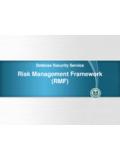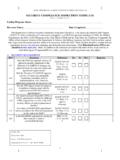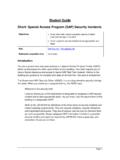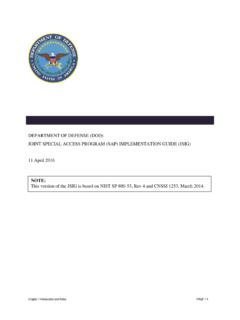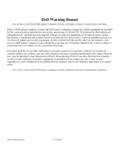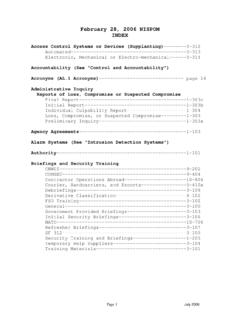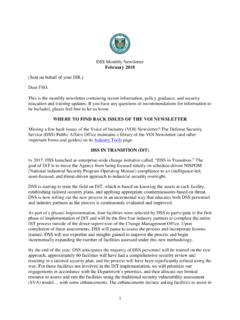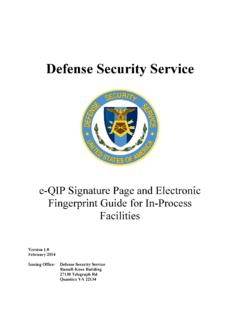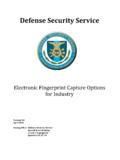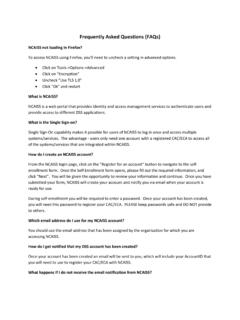Transcription of results of the self Table of Contents
1 Please submit any questions or comments to 1 2016 DSS vulnerability assessment Rating matrix vulnerabilities and NISP Enhancement Categories Incorporating Change 2 (published May 18, 2016) Table of Contents vulnerability Assessments .. 2 vulnerabilities .. 3 NISP Enhancements .. 4 1 Company Sponsored Events .. 5 2 Internal Educational Brochures/Products .. 6 3 Security Staff Professionalization .. 7 4 Information/Product Sharing w/in Community .. 8 5 Active Membership in Security Community .. 9 6 Contractor Self-Inspection ..10 7a Threat Identification and Management .. 11 7b Threat .. 12 8 FOCI/International .. 13 9 Classified Material Controls/Physical Security .. 14 10 Information Systems .. 15 Please note: This revision includes updates from NISPOM Change 2 and ISL 2016-02. Updates have been highlighted in red. Edits have been made based on revisions to NISPOM references, new contractor requirements for implementation of an Insider Threat Program, and changes to the requirements of a contractor self-review.
2 You will notice omission of the example of contractors providing their self-inspection results to DSS prior to the annual SVA as a potential NISP Enhancement area. Contractors are now required to prepare a formal report describing the results of the self-inspection, and a senior management official will certify to DSS in writing on an annual basis that a self-inspection has been conducted (please refer to NISPOM 1-207 Security Reviews for additional information on these updates). In addition, you will notice omission of the example of implementation of an insider threat program under Category 7a as an example of a NISP Enhancement. This is now a NISPOM requirement and all contractors must establish and maintain an insider threat program, designate an Insider Threat Program Senior Official (ITPSO), and train their cleared employees accordingly (please refer to NISPOM 1-202 for additional information).
3 Lastly, with the transition to the Risk Management Framework (RMF), many of the enhancements contained within Section 10 (IS) will become requirements within the 800-53 controls. The NISP Authorization Office (NAO), formerly ODAA, will provide a later update to the Rating matrix to coincide with the transition to RMF that will include enhancements applicable to systems accredited under the Risk Management Framework. Please submit any questions or comments to 2 vulnerability Assessments Overview: The National Industrial Security Program (NISP) was established by Executive Order 12829 to ensure that cleared nse industry safeguards the classified information in their possession while performing work on contracts, programs, bids, or research and development efforts. DSS administers the NISP on behalf of the Department of Defense and 31 other federal agencies.
4 There are approximately 12,800 contractor facilities that are cleared for access to classified information. Per National Industrial Security Program Operating Manual (NISPOM) 1-207, Security Reviews, DSS performs vulnerability assessments of all cleared contractor facilities under its cognizance. The focus of vulnerability assessments is to ensure facilities are compliant with NISPOM requirements such that safeguards employed by contractors are adequate for the protection of classified information. During an assessment a team comprising of one or more DSS Industrial Security Representatives, Information System Security Professionals, and Counterintelligence Special Agents will review the contractor s security program as it relates to each chapter of the NISPOM and interview personnel. Throughout the assessment DSS will identify vulnerabilities and NISP Enhancements (detailed on the following pages).
5 At the end of each assessment , DSS will review the identified vulnerabilities and enhancements and, taking in to consideration the size and complexity of the facility s program, identify an assessment rating of Superior, Commendable, Satisfactory, Marginal, or Unsatisfactory. Following each assessment DSS will provide the Facility Security Officer (FSO) a list of identified vulnerabilities , NISPOM reference, and recommended action to remedy. DSS will then continue to follow up and work with the FSO to help mitigate any outstanding issues. In the rare case of a Marginal or Unsatisfactory rating, DSS will notify the facility s government customers for classified contracts who may discontinue or suspend contract performance. DSS will conduct a compliance assessment within 60 to 120 days to evaluate the facilities corrective actions to identified vulnerabilities .
6 A satisfactory rating will be awarded and government customers notified at the conclusion of the compliance assessment if the vulnerabilities have been mitigated. These ratings are infrequent and it is the DSS goal to partner with industry, ensuring strong security programs are in place to protect classified information. Please submit any questions or comments to 3 vulnerabilities Definition: If a contractor is not in compliance with the requirements of the NISPOM, DSS will identify the issue as either an "Acute vulnerability ", a "Critical vulnerability " or a " vulnerability ." The following further defines each category: Acute vulnerability : Those vulnerabilities that put classified information at imminent risk of loss or compromise, or that have already resulted in the compromise of classified information. Acute vulnerabilities require immediate corrective action.
7 Critical vulnerability : Those instances of NISPOM non-compliance vulnerabilities that are serious, or that may foreseeably place classified information at risk or in danger of loss or compromise. Once a vulnerability is determined to be Acute or Critical, it shall be further categorized as "Isolated", "Systemic", or "Repeat": o Isolated - Single occurrence that resulted in or could logically lead to the loss or compromise of classified information. o Systemic -Deficiency or deficiencies that demonstrate defects in a specific subset of the contractor's industrial security program ( , security education and awareness, AIS security) or in the contractor's overall industrial security program. A systemic critical vulnerability could be the result of the contractor not having a required or necessary program in place, the result of an existing process not adequately designed to make the program compliant with NISP requirements, or due to a failure of contractor personnel to comply with an existing and adequate contractor policy.
8 These defects in either a subset or the overall program may logically result in either a security violation or administrative inquiry if not properly mitigated. o Repeat - Is a repeat of a specific occurrence identified during the last DSS security assessment that has not been properly corrected ( a specific document, system, personnel, etc. issue was identified and reported corrected by the contractor facility but upon the next assessment the exact same document, system, person, etc. the vulnerability still exists). Note: Although some repeat vulnerabilities may be administrative in nature and not directly place classified information at risk to loss or compromise, it is documented as critical. vulnerability : All instances of non-compliance with the NISPOM that are not acute or critical vulnerabilities . For the purposes of Rating matrix scoring, multiple instances of vulnerabilities identified under the same NISPOM reference will be counted as one item.
9 For example, multiple documents not properly marked as required in 4-203. Overall Markings would count as one cited vulnerability . As applicable, DSS will provide contractors a report of each occurrence of the vulnerability for appropriate mitigation action. Clarification: Corrected on the spot (COS) All vulnerabilities identified by DSS will be documented, counted, and points subtracted on the Rating matrix form to include those corrected on the spot. It is important in the DSS assessment of contractor NISP programs that the steps taken to correct vulnerabilities and the measures implemented to prevent recurrence of those vulnerabilities are fully documented. Additionally, if the vulnerabilities prove to be repeat' at subsequent DSS assessments, they are categorized as critical and additional point reductions will occur. DSS encourages contractors to correct all vulnerabilities expeditiously.
10 DSS will appropriately note those items as COS in the security assessment report and a written response to DSS on corrective actions will not be required. Please submit any questions or comments to 4 NISP Enhancements Definition: An enhancement directly relates to and enhances the protection of classified information beyond baseline NISPOM standards. Point credits are given for these procedures and factored into the overall assigned rating. Items to be documented as "NISP enhancements" must relate directly to the NISP, and do not include other commonplace security measures or best practices. NISP enhancements must be validated during the security assessment as having an effective impact on the overall NISP program in place at the company. This validation is usually accomplished through employee interviews and DSS review of processes/procedures. Credit for NISP enhancements will be granted for activities beyond baseline NISPOM requirements even if required by program/contract.
